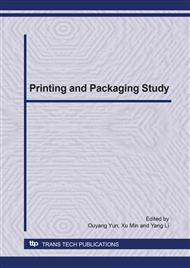p.28
p.32
p.36
p.40
p.44
p.48
p.52
p.56
p.60
Evaluation of CIELAB-Based Color Difference Formulae Using a Printing Data Set
Abstract:
Color difference used to test the quality of printing products is one of the most important factors in the printing industry. Many new color difference formulae such as CIEDE2000, CIEDE94, CMC(l:c) etc were developed to improve the uniformity. In this paper the color difference formulae have been compared throughout their weighting functions SL, SC, and SH to the CIELAB components , , . In order to test which color difference formula has the better performance in the printing industry they are evaluated by our own data sets. First of all, we developed a printing data set for evaluating color difference with psychophysical methods. And the visual color differences of every pairs were obtained. After that the color difference formula mentioned before were evaluated using the data set with the standardized residual sum of squares (STRESS) methods which has better mathematical properties to evaluate the performance of color difference formulae using ΔV and ΔE than PF/3 that cannot indicate the statistical significance of the difference between two color-difference formulae. The result shows that CIEDE2000 and CIE94 color difference formulae are better than CIELAB and CMC. Finally we recommend that the national standards and occupation standards should be updated and CIEDE2000 should be popularized in the printing industry.
Info:
Periodical:
Pages:
44-47
Citation:
Online since:
December 2010
Authors:
Keywords:
Price:
Сopyright:
© 2011 Trans Tech Publications Ltd. All Rights Reserved
Share:
Citation:


